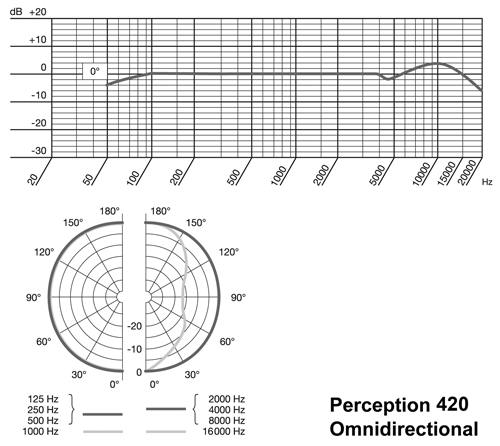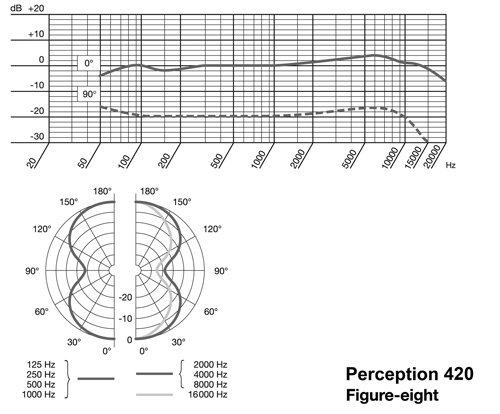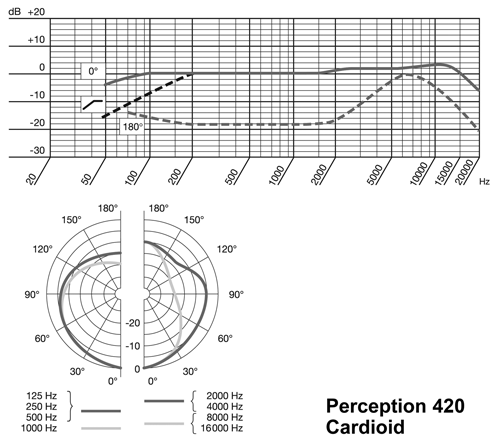THE PERCEPTION 420
With a street price under $300, the Perception 420 replaces the discontinued Perception 400 and is a dual-diaphragm, switchable-pattern, side-address mic that’s intended as a multi-application studio workhorse. It is supplied with a substantial shock mount in an aluminum case, and employs a pair of back-to-back, one-inch capsules, and offers omni, cardioid and figure-8 polar patterns, selectable via a small toggle switch in the same cast zinc-alloy body as the other models. There is also a switchable -20dB pad, along with that low-cut filter switch (300Hz, 12dB per octave), so taken in total there are a lot of features here for surprisingly little money. Other than the blue metallic finish, the Perception 420 looks like what a side-address studio mic should look like, and the general standard of engineering and finish is excellent.

With the pad switched in, the 420 can handle SPLs up to 155dB, and the frequency range is quoted simply as 20 Hz to 20 kHz. But the frequency response curve reproduced here shows a reasonably flat response for all three patterns, although the shape and position of the modest presence peak differs for each of the patterns. Its sensitivity is 28mV/Pa (-31dBV) with an A-weighted signal-to-noise ratio of 78dB, so its performance seems comparable with other well-designed mics of a similar type at this price point. Overall, the mic measures 53 x 165 mm and weighs 525g (18.5 ounces), giving it a substantial feel without making it so heavy as to cause the mic stand to sag.

Although the marketing materials tend to promote the 420 as an all-around instrument microphone, there’s no reason not to use the 420 for voiceovers. Its sound is neutral compared to others — most dedicated vocal mics will have a more pronounced presence peak. The mic’s resistance to popping is better than average, although a pop shield should always be used when recording vocals, and the general tonal character remains reasonably consistent between the three patterns. There’s an audible switching click that occurs when you change patterns, but the circuitry settles down quickly after that.

The cardioid pattern is about what one would expect and, as the frequency plots show, exhibits the flattest frequency response. The omni pattern has a significant bump in the high end, while the figure-8 has the most irregular plot of the three. Further, the figure-8 has less side rejection than other multi-pattern mics I’ve used, and much less than a ribbon, so the conscientious engineer should take this into account. But I usually use switchable polar patterns as a crude form of EQ, and in this way the 420 gave me some different colors to work with.
DON’T WRAP THAT ONE UP, I’LL EAT IT HERE
I have to say that I enjoyed using each of these microphones, and that they all worked just fine. What I find most amazing about them is their price, and how really good they are considering how little they cost. As I said earlier, no engineer is going to mistake them for a Neumann but let’s face it, that probably makes little difference by the time the voice track has been squashed into an mp3 file.
The 120 makes a fine first microphone for voice talent, while VO actors with a few projects under their belt will appreciate the lower noise floor of the 220. The 420 is the best value in the lot as far as I’m concerned, and this one ain’t going back -- it’s staying right here. Even in this crappy economy, a bargain’s a bargain, isn’t it?
The AKG Perception 120 carries a suggested retail in the US of $229.95, while the Perception 220 rings in at $349.95. The Perception 420’s US retail price is $549.95, and all three are discounted by retailers. For more information worldwide, visit www.akg.com.
♦

